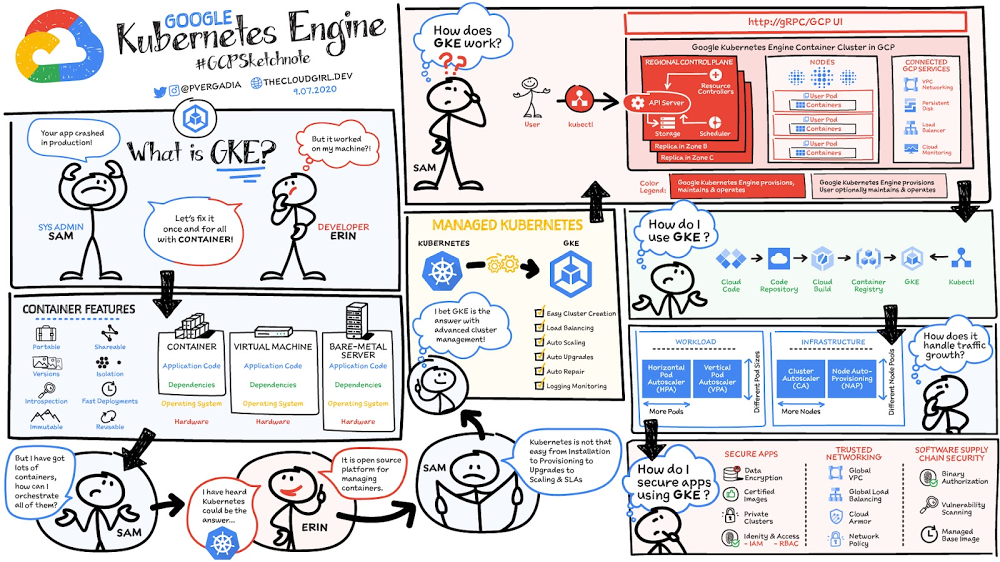Sam (sysadmin) and Erin (developer) work at “Mindful Containers” , an imaginary company that sells sleeping pods for mindful breaks. One day, Sam calls Erin because her application has crashed during deployment, but it worked just fine on her workstation. They check logs, debug stuff, and eventually find version inconsistencies; the right dependencies were missing in production. Together, they perform a risky rollback. Later, they install the missing dependencies and hope nothing else breaks. Erin and Sam decide to fix the root problem once and for all using containers.Why containers?Containers are often compared with virtual machines (VMs). You might already be familiar with VMs: a guest operating system such as Linux or Windows runs on top of a host operating system with virtualized access to the underlying hardware. Like virtual machines, containers enable you to package your application together with libraries and other dependencies, providing isolated environments for running your software services. As you’ll see, however, the similarities end here as containers offer a far more lightweight unit for developers and IT Ops teams to work with, bringing a myriad of benefits.Instead of virtualizing the hardware stack as with the virtual machines approach, containers virtualize at the operating system level, with multiple containers running atop the OS kernel directly. This means that containers are far more lightweight: They share the OS kernel, start much faster, and use a fraction of the memory compared to booting an entire OS.Containers help improve portability, shareability, deployment speed, reusability, and more. More importantly to Erin and Sam, containers made it possible to solve the ‘it worked on my machine’ problem.Click to enlargeWhy Kubernetes?Now, it turns out that Sam is responsible for more developers than just Erin.He struggles with rolling out software:Will it work on all the machines? If it doesn’t work, then what?What happens if traffic spikes? (Sam decides to over-provision just in case…)With lots of developers now containerizing their apps, Sam needs a better way to orchestrate all the containers that developers ship. The solution: Kubernetes!What is so cool about Kubernetes?The Mindful Container team had a bunch of servers, and used to make decisions on what ran on each manually based on what they knew would conflict if it were to run on the same machine. If they were lucky, they might have some sort of scripted system for rolling out software, but it usually involved SSHing into each machine. Now with containers—and the isolation they provide—they can trust that in most cases, any two applications can fairly share the resources of the same machine.With Kubernetes, the team can now introduce a control plane that makes decisions for them on where to run applications. And even better, it doesn’t just statically place them; it can continually monitor the state of each machine, and make adjustments to the state to ensure that what is happening is what they’ve actually specified. Kubernetes runs with a control plane, and on a number of nodes. We install a piece of software called the kubelet on each node, which reports the state back to the master.Here is how it works:The master controls the clusterThe worker nodes run podsA pod holds a set of containersPods are bin-packed as efficiently as configuration and hardware allowsControllers provide safeguards so that pods run according to specification (reconciliation loops)All components can be deployed in high-availability mode and spread across zones or data centersKubernetes orchestrates containers across a fleet of machines, with support for:Automated deployment and replication of containersOnline scale-in and scale-out of container clustersLoad balancing over groups of containersRolling upgrades of application containersResiliency, with automated rescheduling of failed containers (i.e., self-healing of container instances)Controlled exposure of network ports to systems outside of the clusterA few more things to know about Kubernetes:Instead of flying a plane, you program an autopilot: Declare a desired state, and Kubernetes will make it true – and continue to keep it true.It was inspired by Google’s tools for running data centers efficiently.It has seen unprecedented community activity and is today one of the largest projects on GitHub. Google remains the top contributor.The magic of Kubernetes starts happening when we don’t require a sysadmin to make the decisions. Instead, we enable a build and deployment pipeline. When a build succeeds, passes all tests and is signed off, it can automatically be deployed to the cluster gradually, blue/green, or immediately.Kubernetes the hard wayBy far, the single biggest obstacle to using Kubernetes (k8s) is learning how to install and manage your own cluster. Check out k8s the hard way as a step-by-step guide to install a k8s cluster. You have to think about tasks like:Choosing a cloud provider or bare metalProvisioning machinesPicking an OS and container runtimeConfiguring networking (e.g. P ranges for pods, SDNs, LBs)Setting up security (e.g. generating certs and configuring encryption) Starting up cluster services such as DNS, logging, and monitoringOnce you have all these pieces together, you can finally start to use k8s and deploy your first application. And you’re feeling great and happy and k8s is awesome! But then, you have to roll out an update…

Published by